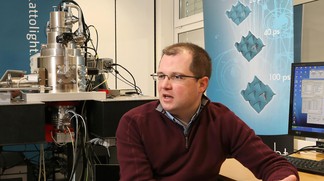Mar 5 2013
Attolight, EPFL’s spin-off, is looking towards the rising sun. While a Singapore based research institute has placed its first order, other sales are being approved in China and a contract with a Japanese distributor is under negotiation. Samuel Sonderreger is the CEO of this young company created in 2008, and he reveals to us the secrets of his entry into the Asian market.
 © 2013 Alain Herzog
© 2013 Alain Herzog
The tool developed by Attolight amounts to a revolution in the observation at nanoscopic scale. It can film moving electrons through the combination of an ultrafast laser with a scanning electron microscope. Its applications include the quality control of chips, LEDs and photovoltaic cells. At a global scale, Asia constitutes the main region where these devices are manufactured; hence its market is showing great excitement about Attolight’s novel tool.
Why did you aim at Asia?
We began by exploring the market of United States’ laboratories, but we felt an unfavorable economic environment. Purchasing our machines requires a significant investment, which wasn’t easy to get approved. At the same time, some researchers from Chinese and Japanese companies contacted us as they were interested in this new generation tool for quality testing. Even though these initial contacts were not successful, we started to feel that there were more business opportunities for our products in the east.
How do large Asian institutions or companies get to trust a Swiss start-up to the point of purchasing high cost equipment from it?
Firstly, we tackled the language and cultural barrier by hiring a Chinese consultant that had carried out her PhD studies at EPFL’s Institute of Quantum Electronics and Photonics. In the autumn of 2011, she established the first contacts with potential representatives. Then, in spring 2012, we travelled to meet them, together with Olivier Gougeon, one of our colleagues. We met about fifteen companies and chose Quantum Design, a U.S. company with a subsidiary in China, to represent us. It was key to be able to find the right people, understand the company’s structure and the financing specifics. Obviously, this would have been impossible without a way of understanding Chinese. Furthermore, EPFL’s excellent reputation helped us enormously. Without the support of Adrienne Corboud-Fumagalli, Vice President for Innovation and Technology Transfer, as well as Benedict Deveaud-Plédran, professor at the Laboratory of Quantum Optoelectronics, it would have been a lot more difficult to break into the Asian market.
What is your advantage in the market, what is a company looking for when it approaches you?
Our device allows testing miniaturized integrated components, which are commonplace in the market of semiconductors, where we are positioned today. It provides information on the material’s structure and the problems that can reduce its long-term durability or influence its effectiveness. We have a big edge over our competitors in terms of ease of use and on-screen image quality.
How is the current economic situation in China?
The current context is quite favorable for us. China has decided to invest in renewable energy. Therefore, this is a great opportunity for start-ups like ours. I am frequently impressed when I see the equipment they use at their research and development establishments, especially among LED manufacturers.
What are your sales expectations in the Asian market?
This year, we are hoping to sell a machine. Then, the idea is to double our sales every year through the applications that our equipment can provide today. At the same time, we are developing new usage scenarios and we are carrying out technical analysis in our laboratory. Some companies send us samples of their material and tell us what to measure. Others send us their specialists, who come to do the measuring themselves.
What are the next markets that you aiming at and how are you going to do so?
Each country has its own culture. We'll adapt our way of doing things. In China, our representatives will contact prospective clients, but the sale will go through us. In Japan, a major scientific instruments company wishes to sell our devices, the main reason being that their customers require having a stock at hand. In Singapore, we also have a representative and we are thinking to do the same with India, Taiwan and South Korea, where we are expected to expand by next summer.
How can you control the work done at the other end of the world when you're a small start-up of 6 employees?
We have our requirements: we demand for a representative to be dedicated to our machine. We are planning to make at least two trips with each representative in order to meet the contacts they’ve established and to ascertain the links they have with potential customers. For example: is he dealing with a technician or a laboratory manager? How does he present the product? Additionally, we ask our potential partners to finance a trip for our representative to come to Switzerland to do a first week of training and for follow-up training each year afterwards. It gives us an idea of the effort they are willing to make. We also ask for regular reports and carry out telephonic interviews every month.